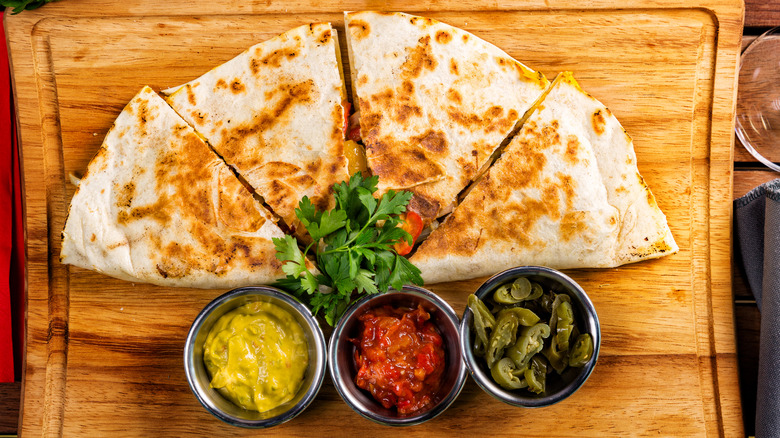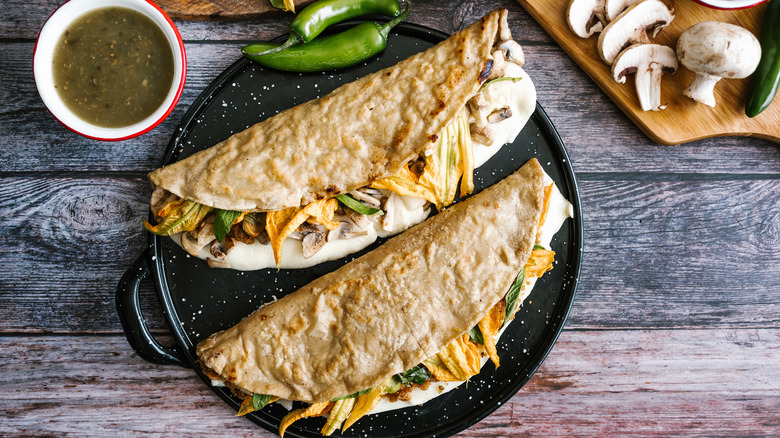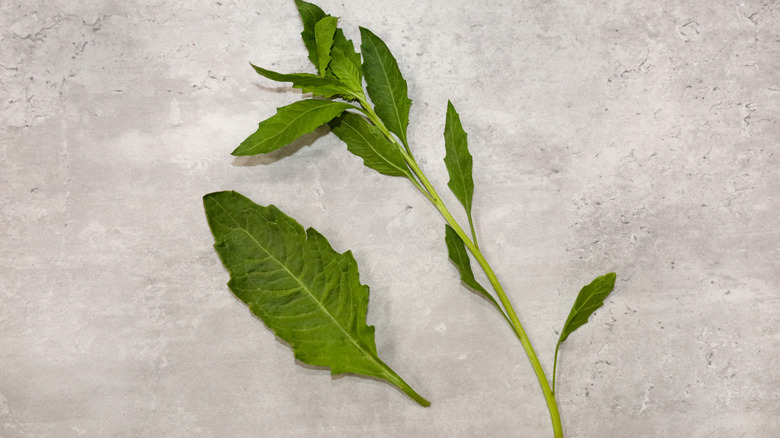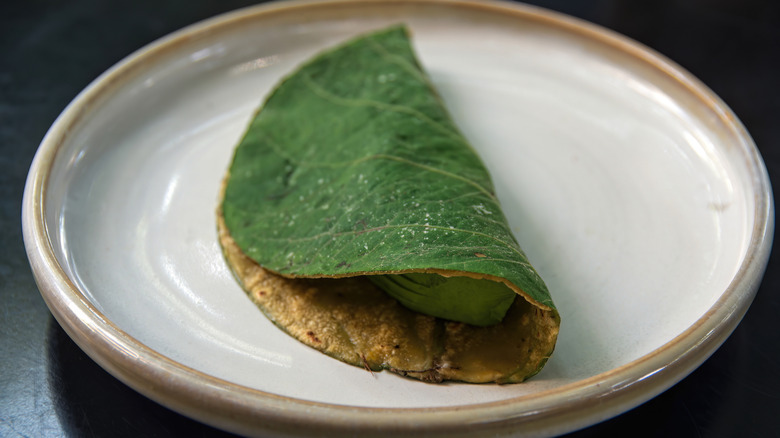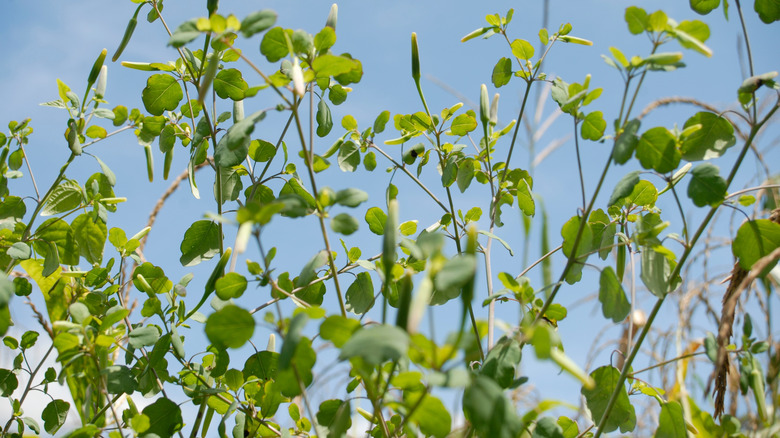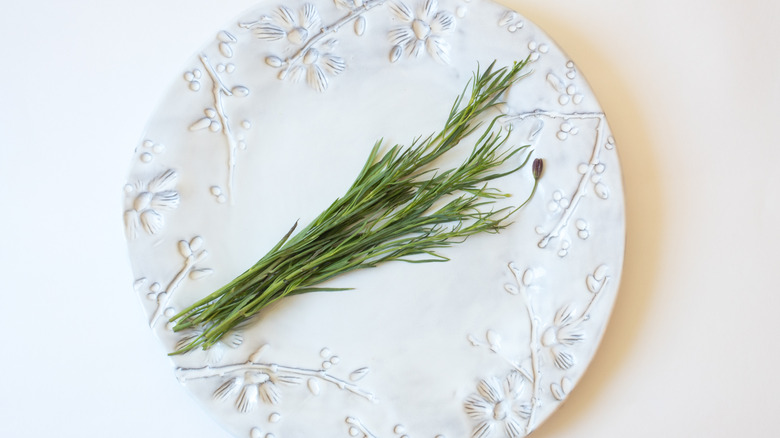5 Unique Ingredients You Should Add To Your Next Quesadilla
There is something truly delightful about a simple cheese quesadilla, but this easy-to-make dish can also act as a blank canvas. For chef Jorge Guzmán, James Beard Award Finalist and owner of Petite León and Chilango in Minneapolis, Minnesota, quesadillas are a perfect vehicle for highlighting interesting flavors. "They are wonderful and so tasty," Guzmán told Food Republic.
A Mexican quesadilla made with a corn tortilla and streamlined fillings is very different from the triangularly cut, heavily stuffed flour tortillas that are commonly served with sour cream and guacamole at Tex-Mex restaurants. Instead, Mexican quesadillas more closely resemble a taco. Traditionally, freshly pressed corn tortillas are cooked from raw on a comal and then folded in half into a semi-circle around any number of fillings.
Stringy, stretchy Oaxacan cheese is classic, but if you can't get your hands on some, go for another mild melting cheese like mozzarella or Monterey Jack. To make them at home, you can use either flour or corn tortillas. Both make for a tasty meal, but if you have never tried the more traditional corn, it is definitely worth it. Toasting the tortilla until it gets just a few charred spots brings out the natural sweetness of the corn and adds a touch of smoke, which pairs perfectly with melty cheese and the intriguing ingredients chef Guzmán likes to use. Most of these additions will only be available at Latin American or Caribbean grocery stores or farmers markets with specialty products.
Squash blossoms are both beautiful and tasty
The flowers of calabaza (summer squash) or pumpkins are sunny yellow with vibrant green streaks on the bottom of the petals. They can be stuffed and fried, stirred into soups and stews, and of course, loaded into quesadillas as chef Jorge Guzmán likes to do.
To prepare them, remove the tough stems, pistils, and stamens first. Squash blossoms available for purchase are usually male, so they have a pollen-producing stamen located in the center of the bloom. The less commonly sold female flowers have a stalky stigma and tendril-like pistils, also located on the inside. Once you pinch out these parts using your fingers or kitchen tweezers, you will be left with just the tender petals.
Squash blossoms are edible raw, so you can just slice the petals thinly, and put them directly inside the quesadilla along with the cheese. They will gently cook as the cheese melts, preserving that bright and earthy flavor. However, they are fairly sturdy, so they can also be lightly cooked ahead of time. Wilt them into a combination of sauteed onions, garlic, and chiles, and use that mixture as your quesadilla filling.
Add pungency with epazote
Boldly flavored epazote is a leafy green herb that Jorge Guzmán loves to put in quesadillas. It is also known as hierba hedionda in Spanish, and skunk weed or goosefoot in English. Its flavor is somewhat similar to oregano, but it also has complex notes of licorice, citrus, and mint.
Either fresh or dried products will work, but fresh epazote has a more pungent and floral flavor that balances out the rich saltiness of cheese very nicely. If you are not used to the taste of epazote, the medicinal quality might be overwhelming, so start by adding just a little bit so as not to overwhelm your palate. Do take note that the fresh herb is very delicate, and the flavors won't withstand prolonged cooking times.
Hoja santa brings peppery complexity to quesadillas
Chef Jorge Guzmán suggested pairing another herb with cheesy quesadillas — hoja santa, which translates to "sacred leaf" in Spanish. Similar to epazote, the taste is much bolder and medicinal when fresh, and it lends notes of black pepper, citrusy nutmeg, anise, and eucalyptus. The large, rounded leaves have tough veins, so it is best to roll them into a cigar shape and slice them crosswise into very thin strips, using the French cooking trick of a chiffonade cut. You can also do a fine chop instead.
Sprinkle the pieces inside the tortilla along with the cheese so that the flavors bloom in the warmth while the quesadilla toasts. For an impressive presentation, you can even press whole hoja santa leaves into fresh masa if you are making corn tortillas from scratch. Either way, hoja santa maintains its deep green color even when cooked, so it makes for a very pretty bite.
Citrusy pápalo brightens quesadillas
In Jorge Guzmán's opinion, mild, creamy, tangy cheese goes hand-in-hand with bright and bold herbs, and pápalo is another intriguing ingredient the chef likes to add to quesadillas. Sometimes called pápaloquelite, the taste is bold and reminiscent of a very lemony cilantro. It has small rounded leaves and thin stems, giving the herb an appearance somewhat similar to watercress.
The stems are quite fibrous, but the tender leaves can be torn to release the aroma and used raw. This is also another case where less is more — the fresh products have a particularly pungent, but still very enticing flavor, that can be overwhelming when used excessively. Treat pápalo more like a seasoning and don't overcook it, or you may lose out on its unique flavor.
Cheesy quesadillas pair well with pipicha
Pipicha, pepicha, pipitza, and chepicha are some of the many names for the last unique herb Jorge Guzmán recommends you add to quesadillas to turn them into something truly special. The plant has very thin, abundant leaves that give bunches of the herb a grassy look.
The taste is fresh, bright, and somewhat medicinal — it leans more in the direction of mint, citrus, pine, and anise. The grassy quality adds zip and zing to cheesy quesadillas, balancing out the salt and creaminess from the dairy. Because this herb has a strong flavor, finely chop it so that you can distribute it evenly throughout the filling. Pair any of these interesting quesadilla combinations with your favorite spicy salsa or pico de gallo for an elevated, chef-approved breakfast, lunch, or dinner!

